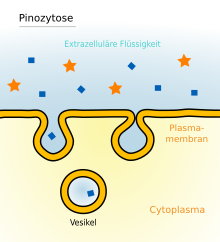Macropinocytosis
As macropinocytosis (also pinocytosis ) refers to the inclusion of amounts of liquid and substances dissolved therein from the surrounding medium of a cell to its interior. The uptake in the cell plasma takes place in the form of vesicles with a maximum diameter of 150 nm. The vesicle is called a macropinosome .
The word is derived from the Greek 'pinein' = drink and 'kytos' = shell.
properties
Macropinocytosis is next to the phagocytosis , the clathrin-mediated endocytosis and the caveolae mediated endocytosis mechanism of endocytosis. Among other things, it occurs in phagocytes . The liquid is absorbed non-specifically without the involvement of receptors for the content. The vesicles then fuse with endosomes and lysosomes in the endomembrane system . In the course of the formation of macropinosomes, Rab7 is increasingly formed. The IP3 kinase and phospholipase C are involved in the formation , whereas cAMP leads to a reintegration of the vesicle into the cell membrane. During the formation of macropinosomes, the phosphoinositides PI (4,5) P2 and PI (3,4,5) P3 are formed and the Rho-GTPase is inactivated. The transport of macropinosomes takes place along the actin - cytoskeleton .
Cell entry for pathogens
The Ebola virus , the vaccinia virus , adenovirus , some picornaviruses and human herpesvirus 8 use Makropinosom-like vesicles for cell entry. The vero toxin formed by EHEC , as well as salmonella , Legionella pneumophila and some protozoa are absorbed into cells via macropinosomes.
Web links
- IUPAC Gold Book, "pinocytosis" . Retrieved July 3, 2016.
Individual evidence
- ↑ Daniel Boujard, Bruno Anselme, Christophe Cullin, Céline Raguénès-Nicol: cellular and molecular biology at a glance . Springer Spectrum, Berlin, Heidelberg 2014, ISBN 978-3-642-41761-0 , pp. 226 , doi : 10.1007 / 978-3-642-41761-0 .
- ↑ http://www.biologie-schule.de/pinozytose.php
- ^ R. Levin, S. Grinstein, D. Schlam: Phosphoinositides in phagocytosis and macropinocytosis. In: Biochimica et Biophysica Acta . Volume 1851, Number 6, June 2015, pp. 805-823, doi : 10.1016 / j.bbalip.2014.09.005 , PMID 25238964 .
- ^ JP Lim, PA Gleeson: Macropinocytosis: an endocytic pathway for internalizing large gulps. In: Immunology and cell biology. Volume 89, Number 8, November 2011, pp. 836-843, doi : 10.1038 / icb.2011.20 , PMID 21423264 .
- ^ A b Y. Egami, T. Taguchi, M. Maekawa, H. Arai, N. Araki: Small GTPases and phosphoinositides in the regulatory mechanisms of macropinosome formation and maturation. In: Frontiers in physiology. Volume 5, 2014, p. 374, doi : 10.3389 / fphys.2014.00374 , PMID 25324782 , PMC 4179697 (free full text).
- ↑ J. Mercer, A. Helenius: Virus entry by macropinocytosis. In: Nature cell biology. Volume 11, Number 5, May 2009, pp. 510-520, doi : 10.1038 / ncb0509-510 , PMID 19404330 .
- ↑ MF Saeed, AA Kolokoltsov, T. Albrecht, RA Davey: Cellular entry of ebola virus involves uptake by a macropinocytosis-like mechanism and subsequent trafficking through early and late endosomes. In: PLoS pathogens. Volume 6, number 9, 2010, p. E1001110, doi : 10.1371 / journal.ppat.1001110 , PMID 20862315 , PMC 2940741 (free full text).
- ↑ M. Valiya Veettil, S. Sadagopan, N. Kerur, S. Chakraborty, B. Chandran: Interaction of c-Cbl with myosin IIA regulates Bleb associated macropinocytosis of Kaposi's sarcoma-associated herpesvirus. In: PLoS pathogens. Volume 6, number 12, 2010, p. E1001238, doi : 10.1371 / journal.ppat.1001238 , PMID 21203488 , PMC 3009604 (free full text).
- ↑ MC Kerr, JT Wang, NA Castro, NA Hamilton, L. Town, DL Brown, FA Meunier, NF Brown, JL Stow, RD Teasdale: Inhibition of the PtdIns (5) kinase PIKfyve disrupts intracellular replication of Salmonella. In: The EMBO journal. Volume 29, number 8, April 2010, pp. 1331-1347, doi : 10.1038 / emboj.2010.28 , PMID 20300065 , PMC 2868569 (free full text).
- ↑ TM de Carvalho, ES Barrias, W. de Souza: Macropinocytosis: a pathway to protozoan infection. In: Frontiers in physiology. Volume 6, 2015, p. 106, doi : 10.3389 / fphys.2015.00106 , PMID 25914647 , PMC 4391238 (free full text).
